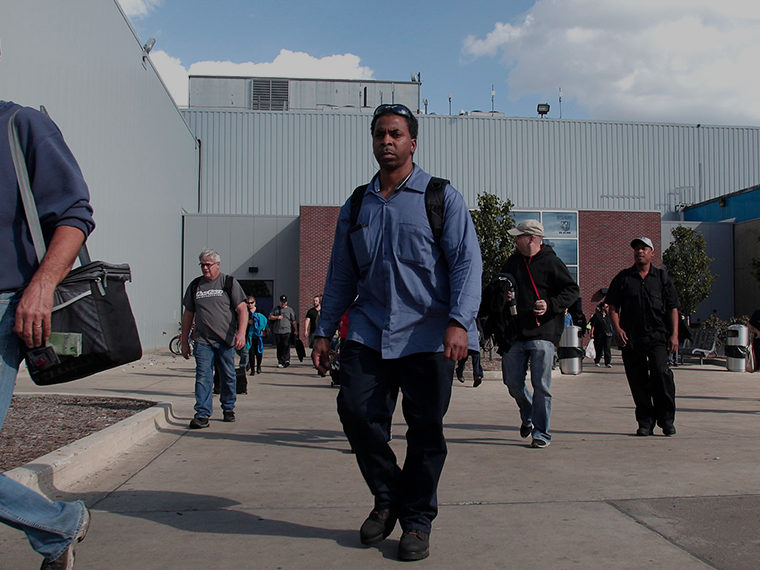Fewer employers = less competition for workers = smaller paychecks
Companies are hiring so much that they have pushed the supply of workers, as measured by the unemployment rate, to its lowest level since 2000. Yet real hourly pay is only slightly higher than it was in the 1970s. While profits ramped up, raises barely kept pace with inflation.
There are many factors behind wage stagnation. One is known as monopsony. A flurry of research links stagnant paychecks to employers that hold more control over local wage rates than the free market might afford. Recent consolidation among employers has left some workers with few places within commuting distance to hawk their skills. Employers in particularly concentrated markets are stingier with pay than their counterparts in more competitive markets, according to the general consensus.
Textbooks typically illustrate monopsony with the example of an old-fashioned company town, where a single employer can pay pittance wages because locals have no other place to work. The counter-example is a city with a multitude of employers, a market in which workers can hope to pit one company against another in seeking top pay. Recent research describes how shrinking competition in some geographic areas and industries, even when multiple employers remain, depresses wages. In those instances, monopsony is implicated in the income inequality that’s plagued an otherwise healthy economy.
Opt In to the Review Monthly Email Update.
These findings have put pressure on government regulators to block corporate mergers that give companies outsized wage-setting power, just as conventional antitrust review prevents mergers that result in monopoly price-setting that harms consumers. The movement gained traction in the last two years, complete with a nod of support from a federal appellate judge who now sits on the U.S. Supreme Court.
Now a working paper offers insights into when and how actual mergers suppress wages. Looking at hospital deals, Northwestern’s Elena Prager and UCLA Anderson’s Matt Schmitt detail how professional pay is held down in the years following some mergers. They outline quantifiable differences in these competition-reducing mergers, which hit pay for skilled workers, and mergers that result in less market consolidation, which have no effect on wage trends.
The study provides further evidence that mergers can give employers control over wages beyond what is expected in a competitive market. But it also offers guidance for antitrust regulators who may soon be required to distinguish between mergers that are dangerous to workers and the many others that are not.
Trapped Professionals, Smaller Raises
When a hospital merger significantly reduces local competition, pay raises for its nurses, pharmacists, administrators and other professionals are notably smaller than those of peers in more competitive markets, according to Prager and Schmitt’s findings. By four years after the merger, cumulative increases in pay for their professional workers are more than 25 percent lower, according to the findings. Before the mergers, the study finds, wage growth in both types of markets are roughly equivalent.
“It’s not like paychecks are shrinking,” Schmitt explained in an interview. “What we’re finding is that wages don’t grow as fast as they do in markets without mergers.”
Alternatively, post-merger raises for hospital janitors, cafeteria workers and other workers in low-skill jobs were on par with competitive markets, according to the study, because their labor is also in demand by other industries.
The findings are consistent with suspicions that corporate mergers are suppressing wages, Schmitt said. Employers can’t pay below market wages for low-skilled labor, because those workers can leave for jobs in other industries. But a merger can reduce the job options for nurses and other employees with skills that don’t easily transfer outside of hospitals, leaving them to accept more readily whatever wages the merged company offers.
However, the degree of consolidation — how much the merged company grew in comparison to its combined local competitors — makes a huge difference in whether workers lose future pay in the deals. Hospital mergers that only modestly reduced local competition had no effect on any employee pay raises, according to the study.
Roughly, Schmitt said in the interview, two local hospitals’ merging affected wages only if there were five or fewer hospitals there to begin with. When a merger took the competition down from six hospitals to five, for example, the study found no difference in wage growth from hospital markets without mergers.
Will Monopsony Kill Mergers?
Anthem’s recently proposed merger with Cigna would have been the largest in the history of the medical insurance industry. The courts blocked it in 2017, citing classic antitrust reasoning: the merged company would have too much price-setting power over customers.
Writing for the dissent on appeal, then-Judge Brett Kavanaugh argued mainly on the basis that he believed insurance customers would see lower, not higher, prices if the merger was allowed. But he also noted that the government could have blocked the merger based on the wage-setting power Anthem would gain over hospitals and doctors. Had the Department of Justice presented that monopsony objection, Kavanaugh would have remanded the case to the lower court, he wrote.
The caveat, from a famously corporate-friendly judge, was a wake-up call for mergers and acquisitions specialists. According to Kavanaugh’s assessment, monopsony can kill a corporate merger just as effectively as monopoly.
Historically, monopsony is a non-issue in merger review. The U.S. government has never tried to block a corporate merger because it could result in the company’s squeezing workers or suppliers for more favorable rates.
But a decade of economic recovery that’s enriched corporations but done little for workers has led policymakers to take a harder look at monopsony. The Federal Trade Commission hosted hearings last fall that included, for the first time, serious discussion on whether the agency should access risks to laborers, not just consumers, in the merger review process.
At the Federal Reserve’s annual mountain retreat last August, central bankers debated whether shrinking competition for labor was detrimental to the broader economy. Invited speakers included Princeton University economist Alan Krueger, who told the group that U.S. annual wage growth is 1–1.5 percentage points below where the laws of supply and demand suggest it should be. He noted forces that traditionally balance worker and employer wage power, such as collective bargaining, have declined at the same time that the number of places to hawk a trade shrank in many markets.
Along with academics and activists, the Bureau of Labor Statistics took note last year of early results from another study that suggested employer consolidation had led to labor exploitation across industries. Most U.S. labor markets today are highly concentrated, offering workers fewer employer options than they have in the past, according to the study. Mining data from the online jobs site CareerBuilder, the study found wages are as much as 17 percent lower in highly concentrated markets than competitive markets.
Using merger review to prevent abusive wage-setting remains a controversial idea. Many factors outside of merger activity affect the size of paychecks. The goal for researchers now is to separate wage effects caused by employers’ gaining dominance through mergers from those naturally occurring in the market.
Antitrust Policy Updated?
While research generally agrees that wages are lower in highly concentrated markets, research linking lower wages directly to employer mergers has been sparse. The distinction is important if antitrust regulators hope to prevent monopsony through beefed-up merger review. Antitrust laws can’t, for example, prevent companies from going out of business, an issue that naturally leaves surviving employers with more bargaining power over workers.
Prager and Schmitt set out to determine if actual mergers led to suppressed wages, and to isolate merger situations that make paychecks vulnerable. Rather than take the standard research route of comparing concentrated to unconcentrated commuting zones, their analysis includes only commuting zones where mergers were the obvious cause of reduced competition. (A commuting zone is a labor market in which local residents typically work.)
Excluding places with mergers in multiple years, the study identifies 84 zones where a single merger between 2000 and 2010 reduced the number of hospitals. They tracked pay by job for four years prior and four years after each merger, at each of the 569 hospitals in these zones.
The study parses the mergers into four groups, based on how dramatically they reduced local competition. Worker pay was studied in three groups: skilled workers in non-medical positions, such as administration or human resources staff; nurses and pharmacists; and unskilled jobs not specific to health care.
Wage suppression followed only mergers that created the highest degree of consolidation. In this category, nurses and pharmacists recorded annual pay raises at 1.7 percentage points below their colleagues in more competitive markets, according to the findings. Their wages at the end of four years were 6.3 percent lower. The skilled non-medical professionals involved in mergers lost about 1.1 percentage points in annual wage growth, for wages about 4.1 percent lower at the end of four years. Wage trajectories for workers in unskilled jobs not specific to health care were unchanged after merger activity.
While the findings point to monopsony, the researchers considered, and rejected, several alternative explanations. They found no evidence that merging hospitals shifted to less expensive laborers, such as by replacing registered nurses with licensed practical nurses. They also found no change in wage trajectories when mergers did not reduce local competition, such as when an out-of-market company takes over a local hospital.
Like other research, this study found that mergers involving union workers maintained more consistent pay raises afterward. The threat of unionization also appeared to mitigate wage losses; wage gains were slower at hospitals merging in so-called right-to-work states (where legislation has undermined union organizing), regardless of whether the workers were unionized, according to the findings.
Inequality and Backlash
Findings from the Prager and Schmitt study and other research have implications for large corporations and their investors. Corporate profits have soared, but labor’s share of total income remains near all-time lows. The top earners are getting raises, while wages are stagnant for the bottom half of workers. In the face of such disparity, many are eager to either impose higher taxes on the wealthy or mandate higher wages for workers.
If research about monopsony convinces antitrust regulators that some corporations hold outsized labor market power, mergers could be subjected to a second, fundamental test of market power.
Featured Faculty
-
Matthew Schmitt
Adjunct Assistant Professor of Strategy
About the Research
Prager, E., & Schmitt, M. (2018). Employer consolidation and wages: Evidence from hospitals.
Azar, J., Marinescu, I.E., & Steinbaum, M. (2018). Labor market concentration.






